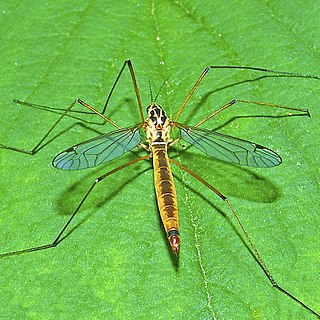
Psila fimetaria is a species of fly, a member of the family Psilidae.

Campiglossa loewiana is a species of fly in the family Tephritidae, the gall flies. The species is found in the Palearctic. The body is black brown; the upper part of pleuras and the midline of the scutellum dirty yellow. Femora 1 and III more or less browned.Oviscapte is a shiny black.Long. : 3-4 mm. The larvae feed in flower heads of Solidago virgaurea and Aster amellus.

Lonchaea chorea is a species of fly in the family Lonchaeidae. It is found in the Palearctic. The larva develops in cow dung.

Agromyza nigripes is a species of fly in the family Agromyzidae. It is found in the Palearctic. The body is black. The thorax and abdomen are shiny. There are 1 + 4 dorsocentral bristles and 7 rows of acrostical bristles. The wing veins are brown, yellow at the base. Long. : 2–3,5 mm. The larva makes serpentine mines in Medicago sativa leaves.

Nemorimyza posticata is a species of fly in the family Agromyzidae. It is found in the Palearctic.

Agromyza nana is a species of fly in the family Agromyzidae. It is found in the Palearctic. Description of imago-Interocular space red. Antennomeres 1 and II red. Peristoma and palps black. Dorsocentral bristles : 1 +3 subequal; acrostics in four rows. Legs black, knees red. Abdomen black with lighter pruinosity than the thorax. Long.:1,75-2,5 mm. The larva mines Trifolium pratense, Melilotus altissima, Medicago.

Phytomyza affinis is a species of fly in the family Agromyzidae. It is found in the Palearctic. Description of imago-Antennomere III brown black, 1-11 red. Mesonotum matt black lateral parts and notopleural depression yellow. Acrosticals in 2-4 rows. Coxae 1 yellow basally, II-III blackish. Femora yellow. Base of femora, tibiae and tarsi black. Abdomen brown black. Tergites with a yellow apical line dilated at the sides. Long. : 2,5–3 mm. The larva mines Cirsium arvense and also feeds on seeds of Euphrasia.

Chamaemyia flavipalpis is a species of fly in the family Chamaemyiidae. It is found in the Palearctic. and North Africa.
Gymnochiromyia flavella is a species of fly in the family Chyromyidae. It is found in the Palearctic.

Dictya umbrarum is a species of fly in the family Sciomyzidae. It is found in the Palearctic and Nearctic. Long. : 4-5 mm. Intensely spotted wings.The interocular space with a black mark at the anterior orbital.The face is white with a black or brown central point. The antennae are reddish, the arista yellow at the base.The body is black covered in a grey yellow pruinosity with shifting (changeant) brown spots on the abdomen.The femora are grey with a brown apical band.The tibia are yellow with a brown apical ring (anneau). For terms see Morphology of Diptera. Dictya montana is a predator of aquatic pulmonate snails with no apparent parasitoid tendency.

Elgiva cucularia is a species of fly in the family Sciomyzidae. It is found in the Palearctic .Long. : 5-8 mm.Overall it is coloured yellowish-brown with a bluish-gray body. The head is characterized by silky black dots at the bases of the anterior orbital setae, between the bases of the antennae and the edges of the compound eyes, and in the centre of the occiput. The third antenna segment is a little shorter than the second. The mesonotum is black with a grey ground and grey pruinosity.There are longitudinal, brown stripes on the dorsum of the thorax: two narrow in the middle and two wide on the sides. One mesopleural bristle amongst short setae.The prothorax is bare. The yellowish smoky wings are 5.2 to 6.8 mm long and have fuzzy spots on the front half. The legs and abdomen are yellow. The lower surfaces of the hind femora are equipped with setae, while the front pair lacks them.The abdomen is rufous.For terms see Morphology of Diptera. Larvae of E. cucularia are predators of aquatic, pulmonate snails in the families Lymnaeidae, Physidae, and Planorbidae.

Lauxania cylindricornis is a species of fly in the family Lauxaniidae. It is found in the Palearctic.Long 2-3.5mm. Small glossy black with yellowish wings black at the base. The porrect, cylindrical antennae are longer than the head. The habitat is lush vegetation in marshes. The larvae feed on micro-organisms within decaying plant tissues

Sciara hemerobioides is a species of fly in the family Sciaridae. It is found in the Palearctic.

Nephrotoma flavipalpis is a species of crane flies in the family Tipulidae.

Ditaeniella grisescens is a species of fly in the family Sciomyzidae. It is found in the Palearctic.-Long. : 3.5-4 mm.The body is short, narrow, obscure above, with a rather thick yellowish ashy pruinosity. The legs are rufous with tibiae 1 and their tarsi browned. Wings clear: the subcostal cell yellow. For terms see Morphology of Diptera.

Parydra aquila is a species of fly in the family Ephydridae. It is found in the Palearctic. Jizz Face brilliant green-black. Tarsi red brown, never black. Long. : 3,5–5 mm. May to December. By ponds.

Ensina sonchi is a species of fly in the family Tephritidae, the gall flies. It is found in the Palearctic . The head is light yellow head. Greenish body with yellow villae. The disc of the mesonotum is blackish. Black mesophragm. The legs and halteres are dirty yellow. Wings vitreous or opaline. Abdomen black: tergites tightly yellow at posterior margin with black villi; rufous sternites; Macrochaetes yellowish. Oviscapte black, apex and sides rufous, with fine, yellowish villi. -Long. : 3-3.5 mm. The larvae feed on the flower heads of Asteraceae.

Minettia longipennis is a species of fly in the family Lauxaniidae. It is found in the Palearctic.

Nephrotoma cornicina is a species of fly in the family Tipulidae.

Opomyza petrei is a species of fly in the family Opomyzidae. It is found in the Palearctic.



















